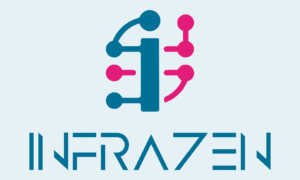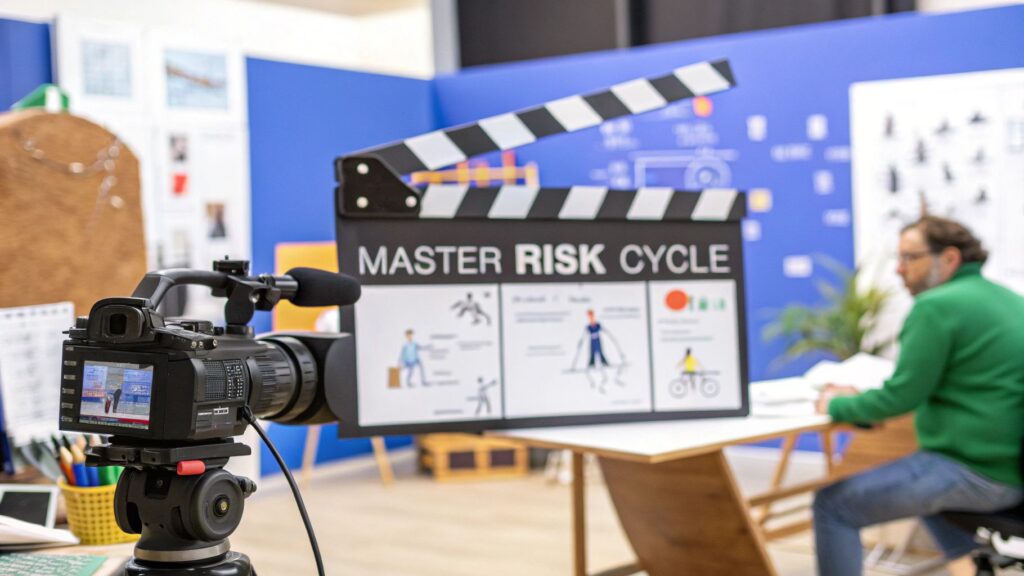When people in creative studios hear the term ‘risk management’, they often picture soul-crushing corporate bureaucracy designed to stamp out new ideas. I get it. But the reality is the complete opposite.
Done right, risk management doesn't stifle creativity; it builds a protective barrier around it. It's the framework that allows brilliant, ambitious ideas to actually flourish without getting derailed by completely preventable chaos.
Think of it like a film production. A director has a creative vision, sure, but that vision relies on someone managing countless risks—what if bad weather delays the big outdoor shoot? What if the lead actor gets sick? What if the special effects budget spirals out of control? Proactively managing these issues is what ensures the film gets made on time, on budget, and true to the original vision.
The risk management lifecycle provides that same stability for your studio. It’s a structured, four-stage process that businesses use to identify, assess, mitigate, and monitor potential threats. It's not a rigid set of rules, but a continuous, repeating loop that protects your projects, your budgets, and your best creative thinking from nasty surprises.
The Four Stages of Creative Resilience
This isn't a one-and-done checklist. The lifecycle operates as a continuous framework where each stage feeds directly into the next, creating a dynamic system for protecting your work.
It’s such a foundational process that even governments use it to prepare for massive, national-level threats. Just look at the UK's dynamic approach to its National Risk Register. They have a whole methodology for assessing reasonable worst-case scenarios, which just goes to show how valuable a structured process is, no matter the scale.
To give you a clearer picture, here's a quick breakdown of what each stage involves.
| Lifecycle Stage | Primary Objective | Key Activity Example |
|---|---|---|
| Identify | Proactively search for and document potential threats before they surface. | A brainstorming session where designers, project managers, and clients list everything that could go wrong with a project launch. |
| Assess | Analyse each risk to understand its potential impact and how likely it is to occur. | Ranking the identified risks from 'low impact, low likelihood' to 'high impact, high likelihood' to prioritise focus. |
| Mitigate | Develop and implement a plan to reduce, transfer, or accept the risk. | Deciding to purchase extra cloud storage to avoid a "storage full" error right before a deadline (reducing the risk). |
| Monitor | Continuously track risks and the effectiveness of your response plans. | Setting a recurring calendar reminder to check the status of your project backups and review your mitigation plans. |
This table shows how the process flows from discovery through to action and review, ensuring you're always prepared.
The infographic below really nails how a team might kick this process off, starting with that all-important first step: identification.

As you can see, great risk management always starts with a conversation. It's about bringing different perspectives to the table to uncover potential issues someone working in a silo might miss.
By treating risk management as a superpower, you transform it from a corporate chore into a strategic tool. It's the framework that gives you the confidence to take on ambitious, exciting projects, knowing you have a solid plan to handle whatever comes your way. This isn't about trying to eliminate all risk—it's about managing it smartly so you can get back to focusing on creating amazing work.
Uncovering the Hidden Risks in Your Projects

The first stage of any solid risk management lifecycle is simply spotting the dangers. It’s an obvious point, but one that’s easy to miss: you can't manage a risk you don't even know exists. For creative projects, the most dangerous threats are often the ones you never see coming, lurking just beneath the surface of what looks like a smooth process.
To do this well, you need to move beyond a simple brainstorm. One of the most powerful techniques I’ve seen teams use is the 'pre-mortem'. It’s a bit counterintuitive. You start by imagining your project has already failed spectacularly. Now, get the team together and work backwards to figure out exactly what went wrong.
This clever exercise gives people the freedom to voice concerns without sounding like they're just being negative. It shifts the focus from a vague "what could happen" to a much more concrete "what did happen," making potential issues feel real and urgent. You’ll be stunned by the candid insights that pop up when the pressure to be optimistic is off the table.
Learning from Past Projects
Your studio's history is a goldmine of data. Digging into past projects—both the wins and the ones that went sideways—helps you spot the recurring villains that steal time, kill creativity, and blow budgets. Look for patterns. Is it always scope creep? Confusing client feedback loops? Or those nasty, unforeseen technical snags?
A proper review can uncover systemic issues you'd otherwise miss. For instance, do projects consistently go over budget right at the final delivery stage? That could point to a weakness in your initial estimating process or a recurring headache with last-minute client changes. These historical clues are your best defence.
By fostering a studio culture where flagging a potential issue is seen as a contribution, not a complaint, you empower your entire team. This collective vigilance transforms risk identification from a manager's task into a shared responsibility, strengthening your project outcomes.
Building Your Studio's Risk Register
To make this process stick, you need to formalise it. Start building a risk register—basically, a central document that lists every potential threat you can think of. For creative studios, these risks tend to fall into a few key categories. Using a checklist approach ensures you cover all your bases, from your internal team to the outside suppliers you rely on.
Here are some common risk categories to get you started:
- Technical Risks: Will that new software integration actually work as planned? Is there a mountain of technical debt in the codebase that’s just waiting to cause problems down the line?
- Resource Risks: Is your whole project leaning heavily on one brilliant designer or developer? What’s the plan if a key team member gets sick or suddenly leaves?
- Third-Party Risks: How reliable are your freelancers, your hosting provider, or your stock imagery supplier? A failure on their end can directly torpedo your project.
- Cybersecurity Risks: Protecting project files and sensitive client data is non-negotiable. This is where strong security measures are critical. You can get a sense of how specialised protection works by learning about solutions like managed endpoint detection and response.
This register isn't just a list; it becomes the foundation for the entire risk management process. It’s what you’ll use in the next stage, assessment, where you start prioritising these threats.
How to Prioritize Risks Without Getting Overwhelmed

Once you’ve listed out all the things that could go wrong on a project, it’s easy to feel paralysed. That sprawling list of potential disasters is a sure-fire recipe for anxiety.
But here’s the secret: not all risks are created equal. The assessment phase of the risk management lifecycle is all about separating the genuine, high-priority threats from the low-level background noise. It’s about cutting through the chaos.
This step stops your team from wasting time and energy on minor hiccups while a major catastrophe is brewing unnoticed. Think of it like a hospital's triage system—you don't treat a sprained ankle before a heart attack. You figure out what’s most severe first, so you can focus your resources where they’re desperately needed.
For creative studios, this is where you turn a jumble of vague worries into a clear, prioritised action plan. The most effective way I've seen teams do this is by using a classic tool: the risk assessment matrix.
Using the Risk Assessment Matrix
The matrix is a brilliantly simple but powerful concept. It helps you score every risk you've identified based on two critical factors: its potential impact on the project and the likelihood of it actually happening.
By plotting these two scores against each other, you can instantly see which risks demand your immediate attention. It transforms a nagging feeling into something tangible that you can actually do something about.
Let's break down how to score these factors in a creative studio context:
- Impact Score: This measures how much damage the risk could do if it materialised. A minor client delay on feedback might be a 1 (low impact), but a catastrophic server failure that deletes all your project files? That’s a definite 5 (critical impact).
- Likelihood Score: This is your best guess on the probability of the risk occurring. A freak snowstorm in July halting a photoshoot is probably a 1 (very unlikely), whereas a key team member catching a common cold during flu season might be a 3 (possible).
Once you've given each risk an impact and a likelihood score (say, on a scale of 1 to 5), you plot them on the grid. The risks that land in that top-right "high impact, high likelihood" quadrant are your red alerts. They’re what you need to tackle first.
A risk assessment isn't about perfectly predicting the future. It's about making informed, professional judgements to direct your focus. This methodical approach ensures your team's valuable time is spent solving the problems that pose the greatest danger to your timeline, budget, and reputation.
Creative Studio Risk Scenarios
Let's make this real. Compare two common scenarios to see the matrix in action.
Scenario A: Key Designer Catches the Flu
- Impact: High (4/5). If they're the only one with specific skills, their absence could bring progress to a grinding halt.
- Likelihood: Low-to-Medium (2/5). It's possible, especially in winter, but it's not a daily probability.
Scenario B: Consistent, Minor Client Delays
- Impact: Low (2/5). A single one-day delay is annoying but manageable.
- Likelihood: High (4/5). This particular client has a track record of slow feedback loops.
Looking at these, the designer getting sick has a much bigger immediate impact. But the slow-drip of consistent client delays might actually pose a greater cumulative threat to the project's timeline and budget.
The matrix helps you see this nuance. It allows you to prepare for both—perhaps by cross-training another designer to cover key skills (mitigating Scenario A) and building extra buffer time into the schedule (mitigating Scenario B). This is the assessment stage doing its job, giving you the clarity to act, not just react.
Building Your Practical Risk Response Plan
Knowing what could go wrong is one thing; knowing what to do about it is a completely different ball game. Once you’ve assessed and prioritised the threats facing your studio, it’s time to build a clear, decisive action plan. This is where you move from just being aware of problems to being equipped with solutions.
For every significant risk on your list, you really only have four fundamental strategies to choose from. Think of them as a playbook. This structure is what moves your studio from a state of reactive panic to one of proactive control, turning potential project disasters into minor, manageable hiccups.
The Four Core Risk Responses
Your response plan doesn't need to be some thousand-page document. It boils down to choosing one of four distinct actions for each high-priority risk you've identified.
- Avoid: The most direct approach. You simply decide to steer clear of the risk altogether. For a creative studio, this might look like politely declining a project with a client known for scope creep and late payments, or refusing to use a brand new, unstable piece of software on a mission-critical deadline.
- Transfer: Here, you shift the financial fallout of a risk onto a third party. The classic examples are buying professional indemnity insurance or including specific liability clauses in your client contracts. If something goes wrong, you’re not the only one shouldering the burden.
- Mitigate: This is all about taking active steps to reduce either the likelihood or the impact of a risk. Simple examples include cross-training team members on key design software to avoid a single point of failure, or implementing a robust cybersecurity managed services plan to protect project data from threats.
- Accept: Let's be honest, sometimes the cost of dealing with a risk is far greater than the potential damage. Acceptance is a conscious, informed decision to live with a risk and its potential consequences. This is usually reserved for threats that are low in both impact and likelihood.
Your response plan is your studio's playbook for resilience. It assigns clear ownership and defines the next steps for your most significant risks, turning abstract worries into a set of concrete, actionable tasks that your team can follow when pressure mounts.
This structured thinking is becoming more and more vital. Just look at the UK's Prudential Regulation Authority, which is sharpening its focus on operational resilience for 2025. They're requiring firms to prove they can withstand severe disruptions like cyber threats. It’s a clear signal of a broader trend: having robust, actionable response and recovery plans is no longer optional. You can learn more about the PRA’s 2025 priorities on FinReg-e.com.
Creating this plan ensures that when a risk actually happens, there's no confusion or panic. Everyone knows who is responsible and what needs to be done immediately, protecting your project's timeline, budget, and creative integrity.
A risk register gathering dust on a server is useless. Real resilience comes from making risk management an active, ongoing process, not a one-off task. The final stage of the risk management lifecycle—monitoring—is where you make this happen, weaving it into your studio’s operational DNA.
This isn't about adding more meetings or bureaucracy. It’s about building risk oversight into the rhythms you already have. Think of it as creating a continuous feedback loop: you track threats, see if your responses are working, and know exactly when to adjust your strategy.
Done right, it turns risk management from a chore into a source of quiet confidence for your entire team.
Weaving Risk Into Your Weekly Rhythm
The easiest way to bring risk monitoring to life is to make it a small, standard part of your weekly project meetings. This doesn't need to be some grand, formal presentation. A simple, five-minute ‘risk check-in’ is often all it takes.
During this check-in, the project lead can quickly run through the top three to five risks from the register. It’s a simple action that keeps the most significant threats front-of-mind for everyone involved.
By making risk a regular conversation, you build a culture of shared awareness. It stops being one person's job and becomes a collective responsibility, making the whole team more observant and prepared.
This kind of proactive thinking is becoming essential. In the UK financial services sector, for instance, firms are facing tough new operational resilience rules. By 31 March 2025, they must prove they can withstand major disruptions like cyber attacks. You can see the full details of these UK operational resilience rules on Datamatters.sidley.com.
Using Milestones as Natural Review Points
Beyond the weekly pulse check, project milestones are the perfect moments for a more thorough risk review. These are natural breakpoints in a project where a lot can change.
Use these milestones to ask a few critical questions:
- Have any new risks popped up since we started? A surprise software update or a key client contact leaving could introduce fresh challenges.
- Did our mitigation strategies actually work? If we built in buffer time for feedback, did it successfully absorb the client’s delays?
- Has the priority of existing risks shifted? A threat that seemed unlikely at the start might now feel much more probable.
Answering these questions at key moments—like after the design phase or before a major presentation—keeps your risk register accurate and genuinely useful. It stops your plans from going stale and helps you adapt to a project's reality, turning the risk management lifecycle into a powerful habit for consistent success.
Right, let's stop talking theory and get practical.
Knowing about the risk management lifecycle is one thing, but actually putting it into practice is what will genuinely shield your creative work. And no, this doesn't have to be some bureaucratic nightmare. A simple, lightweight process can slot perfectly into the fast-paced flow of a busy studio, acting as a protective barrier for your most important projects.
The real goal here is to get ahead of those unexpected curveballs that drain creative energy and throw your timelines into chaos. Think of this less as adding red tape and more as building a reliable framework for predictable success. It's about reinforcing your ability to do what you do best: create incredible work without constantly having to fight fires.
A smart risk management process is the ultimate tool for protecting your team's focus and creativity. It's about proactively clearing the path so that brilliant ideas have the best possible chance to come to life, on time and on budget.
Your Simple Implementation Checklist
Getting this started on your very next project is far easier than you might think. This isn't about building a massive, complicated system overnight. It’s about taking small, consistent steps to bake proactive thinking into your studio's DNA.
Here’s a practical checklist to guide you:
-
Start the Conversation (Identify): Before you even kick off, hold a quick 15-minute "pre-mortem." Ask your team one simple question: "If this project goes off the rails, what would be the most likely cause?" Jot these ideas down in a shared document.
-
Quickly Rank Your Risks (Assess): Go through the list and give each risk a gut-check score from 1-3 for both its potential Impact and its Likelihood. This simple step instantly highlights the one or two threats that actually need a concrete plan.
-
Define Your Core Responses (Mitigate): For your top-ranked risks, decide on a single action. Are you going to Avoid it, Transfer it, Mitigate it, or just Accept it? Write down the plan in one clear sentence.
-
Set a Weekly Check-In (Monitor): Carve out just five minutes in your regular team meetings for a "Risk Review." This keeps your plan alive and ensures it stays relevant from the project's start to its finish.
This disciplined approach does more than just protect individual projects; it builds resilience for larger disruptions, which is a key part of any solid IT strategy. To dig deeper into preparing for those bigger what-ifs, check out our guide on creating a business continuity plan for your IT.
Frequently Asked Questions
When we talk about the risk management lifecycle, we often hear the same questions pop up from creative teams. It sounds formal, maybe a bit stiff for a dynamic studio. Let's clear up a few common concerns.
Is This Process Too Corporate For Us?
Not at all. The key is to see it less as corporate bureaucracy and more as structured 'problem-spotting'. For a small, agile team, this doesn't mean generating dense, formal reports that no one will ever read.
It can be as simple as a shared document where you jot down potential project hiccups. By listing what could go wrong (like unexpected client delays or a critical software bug), its potential impact, and a quick plan, you’re just being prepared. The focus is on readiness, not paperwork.
How Often Should We Review Risks?
You don’t need to overcomplicate this. A great place to start is building a quick, 10-minute risk review into your regular weekly team meeting. This keeps potential issues on everyone’s radar without adding another massive task to the pile.
For larger or more complex projects, a deeper review at key milestones works wonders. Think about scheduling a check-in after the discovery phase or just before final delivery. This ensures your plans adapt as the project itself changes.
The most common risk creative studios overlook is key person dependency, where only one individual holds all the knowledge for a critical task. Another frequent blind spot is scope creep disguised as a series of small, "easy" requests from a client that snowball into significant, unpaid work.
This simple, two-tiered approach of weekly check-ins and milestone reviews creates a solid but manageable rhythm for keeping an eye on threats. It keeps your risk management valuable from start to finish.
A solid risk management process is your studio's best defence against the unexpected. At InfraZen Ltd, we help creative agencies build resilient IT frameworks that protect your work and your focus. See how our calm, human-centred approach can secure your studio by visiting us at https://infrazen.tech.

